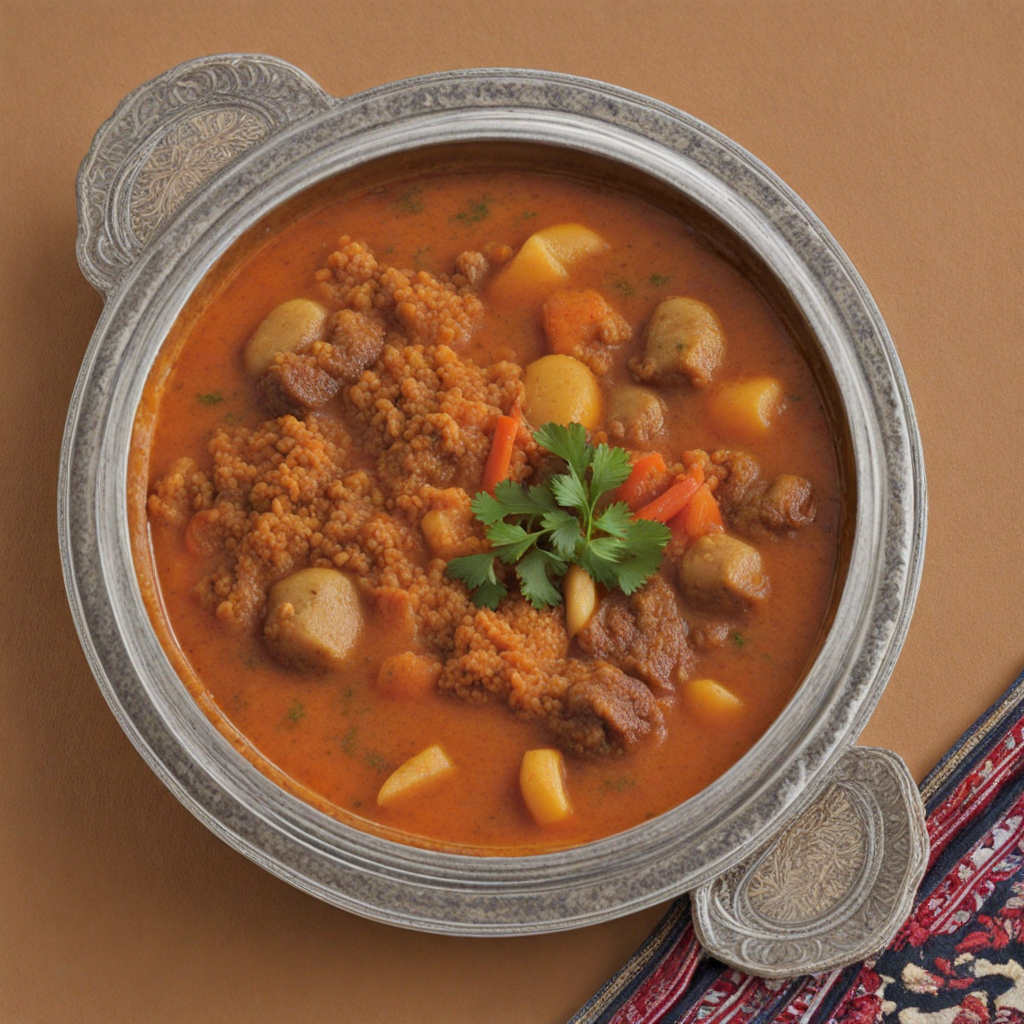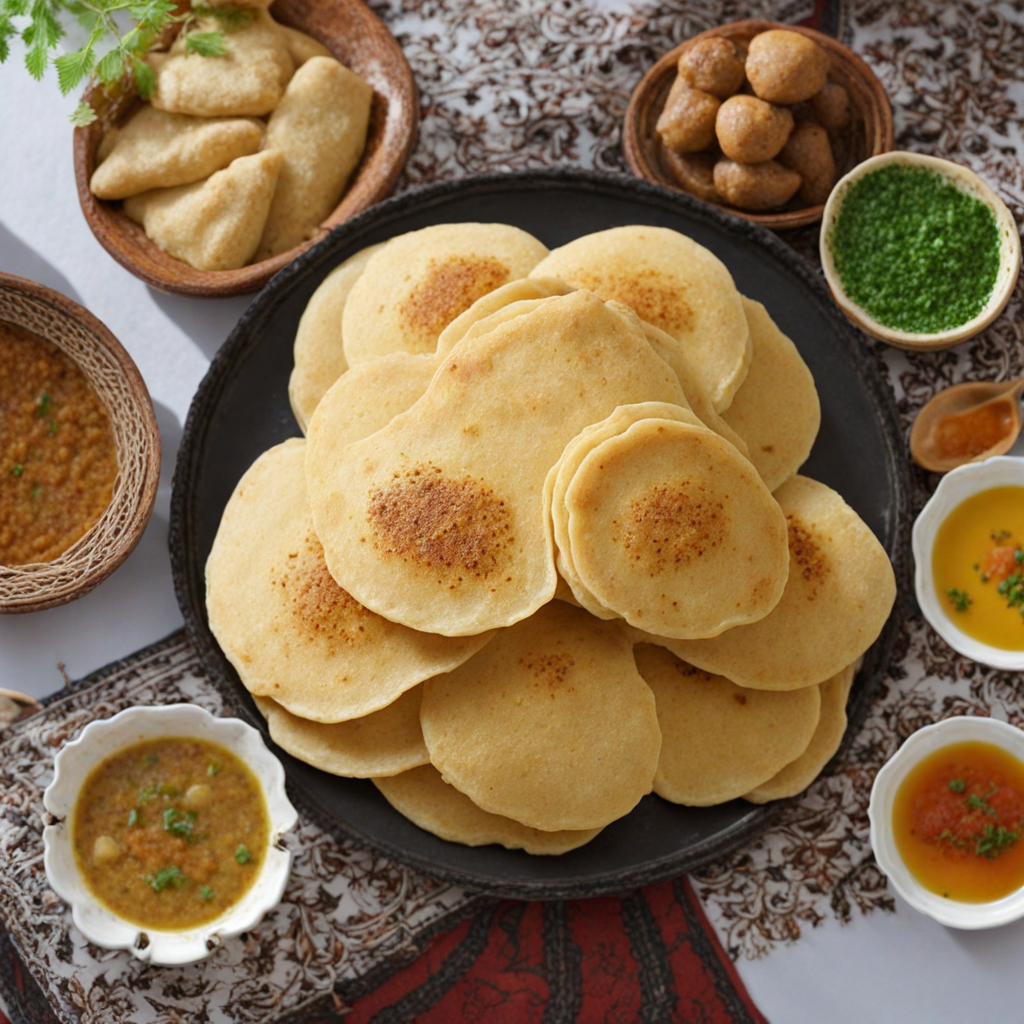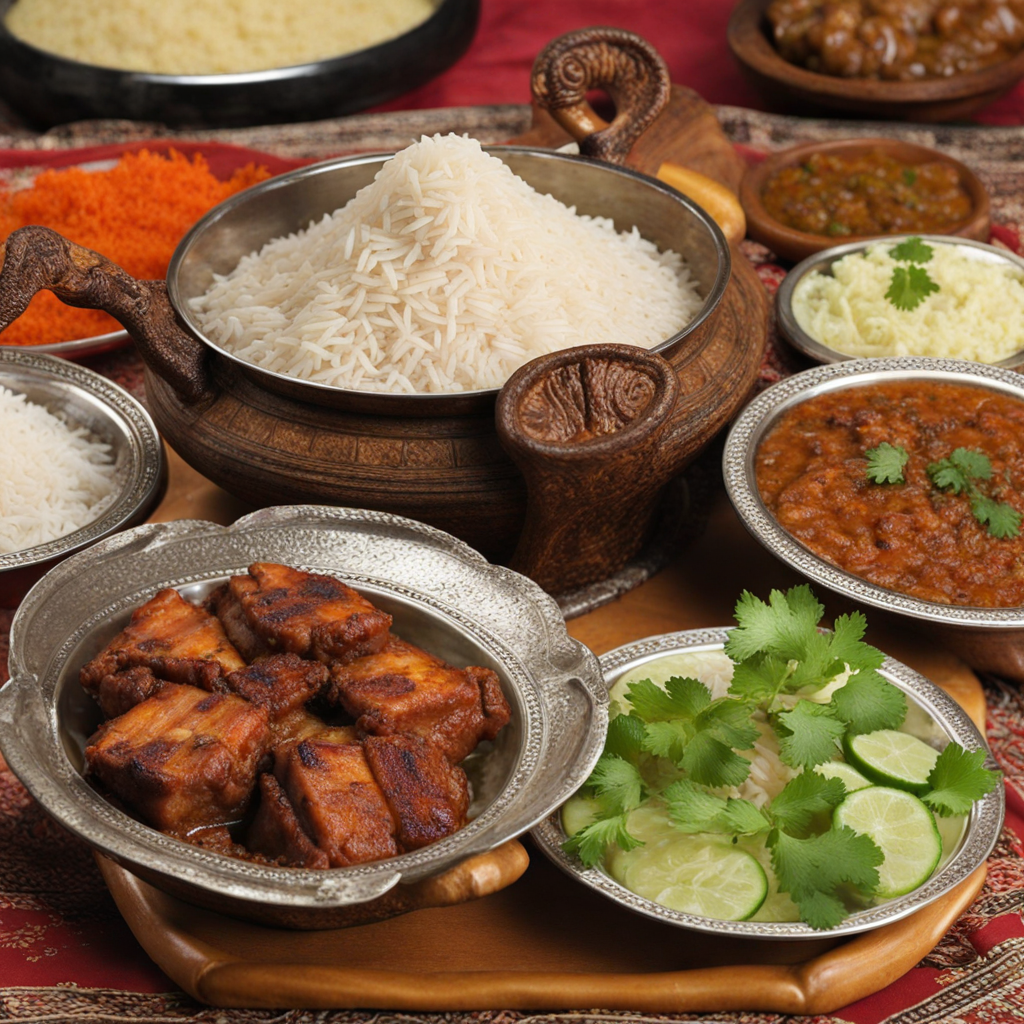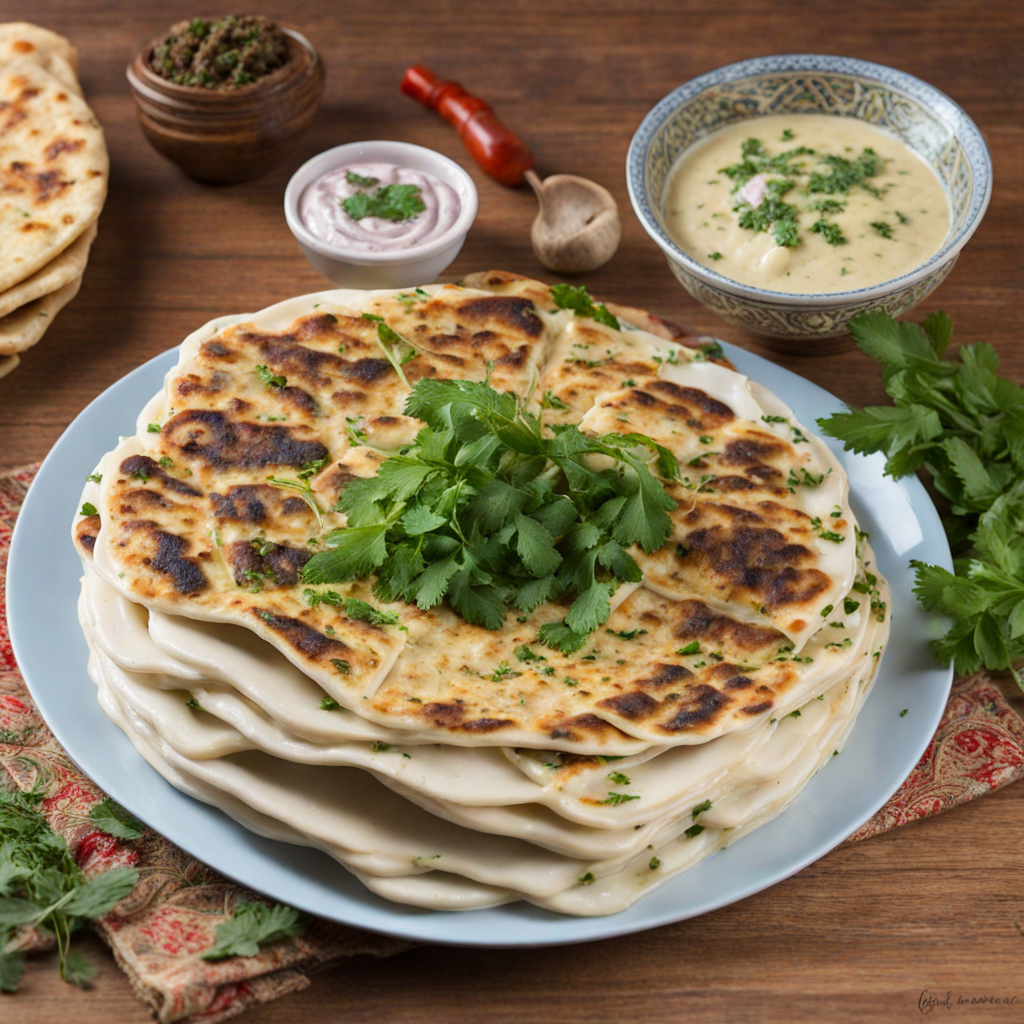Salta
Salta is a beloved traditional dish from Yemen, known for its unique blend of flavors and textures that tantalize the taste buds. At its core, Salta is a hearty stew made with meat, vegetables, and a rich array of spices. The base typically features lamb or beef, which is slow-cooked until tender, allowing it to absorb the aromatic spices that are characteristic of Yemeni cuisine. The addition of vegetables such as tomatoes, potatoes, and carrots not only enhances the flavor but also adds a wholesome element to the dish. The stew is often served bubbling hot in a clay pot, creating an inviting presentation that beckons diners to dig in. The standout feature of Salta is the inclusion of a spicy, herb-infused sauce known as 'Hilbeh,' made from ground fenugreek leaves. This sauce is whipped to a frothy consistency and is served on top of the stew, providing a vibrant green color and a distinctive taste that elevates the dish to new heights. The combination of the warm, savory stew with the slight bitterness and earthiness of Hilbeh creates a complex flavor profile that is both comforting and invigorating. Diners are encouraged to mix the Hilbeh into the stew, allowing the flavors to meld together, resulting in a truly unique culinary experience. Accompanying Salta, you will often find flatbreads like 'Lahoh' or 'Tannour,' which serve as the perfect vehicle for scooping up the stew. The bread is soft, slightly chewy, and complements the richness of the dish beautifully. Eating Salta is not just about the flavors but also about the communal experience; it is traditionally enjoyed with family and friends, fostering a sense of togetherness as everyone shares from the same pot. Discovering Salta is a delightful journey into the heart of Yemeni cuisine, where each bite offers a taste of the country’s rich culinary heritage.
How It Became This Dish
The History of سلتة (Saltah): A Culinary Gem of Yemen Origins of سلتة Saltah, a beloved traditional dish from Yemen, is often regarded as the national dish of the country. Its roots extend deeply into the rich tapestry of Yemeni culture and history, encapsulating the essence of Yemeni hospitality and communal dining. The origins of Saltah can be traced back to ancient Yemeni culinary practices, influenced by various cultural interactions over centuries. Yemen, strategically located at the crossroads of Africa and the Arabian Peninsula, has been a melting pot of diverse cultures, flavors, and ingredients. The spice trade, particularly during the time of the ancient incense routes, brought in various spices that have become integral to Yemeni cuisine. The use of spices like cumin, coriander, and fenugreek in Saltah is a testament to this historical exchange. One of the key components of Saltah is the *duqqa*, a spice mixture that includes ground fenugreek seeds, which is typically prepared fresh and served as a flavorful base. The preparation of *duqqa* is an art form in itself, often passed down through generations. This aromatic blend symbolizes the essence of Yemeni cooking, where spices are used not just to enhance flavor but to create a sensory experience. Cultural Significance Saltah is more than just a dish; it embodies the spirit of Yemeni culture and hospitality. Traditionally, it is served in a communal setting, where family and friends gather around a large platter, reflecting the communal nature of Yemeni society. This practice of sharing food fosters connections and strengthens bonds, making Saltah a dish that transcends mere nourishment. In Yemeni culture, meals are often seen as a time for social interaction and storytelling. Saltah is typically accompanied by *laban* (yogurt) and served with a side of flatbread, which is used to scoop the dish. The act of gathering around Saltah represents unity and togetherness, making it a staple during celebrations, weddings, and religious events. Moreover, Saltah also carries regional variations, reflecting local ingredients and culinary traditions. For instance, in the highlands, you might find *Saltah* enriched with lamb or beef, while coastal regions may incorporate fresh fish. This adaptability showcases how Saltah not only serves as a national dish but also as a canvas for regional creativity. The Development of سلتة Over Time As Yemen has evolved, so too has Saltah. The dish has undergone various transformations influenced by historical events, migration, and globalization. During the Ottoman Empire’s rule over Yemen from the 16th to the 20th century, culinary exchanges flourished, introducing new flavors and cooking methods. The incorporation of ingredients such as potatoes and tomatoes into Saltah reflects this historical influence, showcasing how external factors can reshape traditional dishes. The 20th century saw significant political and social changes in Yemen, especially with the unification of North and South Yemen in 1990. This unification not only influenced political landscapes but also culinary practices. Saltah began to gain recognition beyond local boundaries, becoming a symbol of Yemeni identity in a rapidly globalizing world. In the diaspora, particularly in countries like Saudi Arabia, the United States, and the United Kingdom, Yemeni immigrants have introduced Saltah to diverse audiences, allowing the dish to evolve while retaining its core essence. Yemeni restaurants, particularly in major cities, have made Saltah accessible to a broader audience, often adapting the dish to cater to varied palates while maintaining its authenticity. Preparation and Ingredients The traditional preparation of Saltah involves several key components. The dish typically consists of a thick, stew-like base made from meat (often lamb or beef), vegetables, and the signature *duqqa*. The main components include: 1. Meat: The choice of meat varies, but lamb is most commonly used. It is often simmered to tenderness with spices and vegetables. 2. Vegetables: Common additions include potatoes, carrots, and green beans, which provide texture and flavor. In some variations, fresh herbs like cilantro and parsley are also incorporated. 3. Duqqa: The heart of Saltah, this spice mix not only flavors the dish but also provides a unique aroma that is characteristic of Yemeni cuisine. 4. Bread: Freshly baked flatbreads, such as *lafa* or *tannour*, are critical for scooping up Saltah, enhancing the communal dining experience. The preparation of Saltah is often a communal event in itself, with family members coming together to cook, share stories, and enjoy the process. The aroma of spices simmering on the stove fills the home, creating an inviting atmosphere that epitomizes Yemeni hospitality. Modern Interpretations and Global Influence In recent years, there has been a resurgence of interest in traditional Yemeni dishes, including Saltah, as people seek authentic culinary experiences. The rise of food blogs, social media, and cooking shows has allowed chefs and home cooks to showcase this rich dish to a global audience. Innovative interpretations of Saltah are emerging, with chefs experimenting with fusion elements, incorporating modern cooking techniques, or presenting the dish in contemporary styles, while still honoring its roots. As Yemen faces numerous challenges, the diaspora community has taken it upon themselves to preserve and promote their culinary heritage. Events like Yemeni food festivals and cooking classes have become avenues through which the younger generations learn about their roots and share their culture with others. Conclusion Saltah is more than just a dish; it is a reflection of Yemen's history, culture, and resilience. As it continues to evolve, it remains a symbol of unity, hospitality, and the rich culinary traditions that define Yemeni identity. From its ancient origins to its modern interpretations, Saltah captures the spirit of a nation, reminding us of the power of food to connect people, tell stories, and preserve heritage. In every spoonful of Saltah, one can taste the history and heart of Yemen, making it not just a meal but an experience to be cherished and shared.
You may like
Discover local flavors from Yemen







